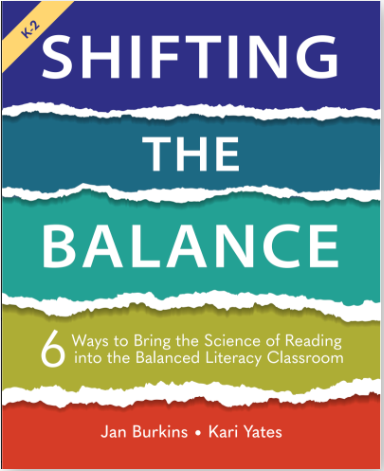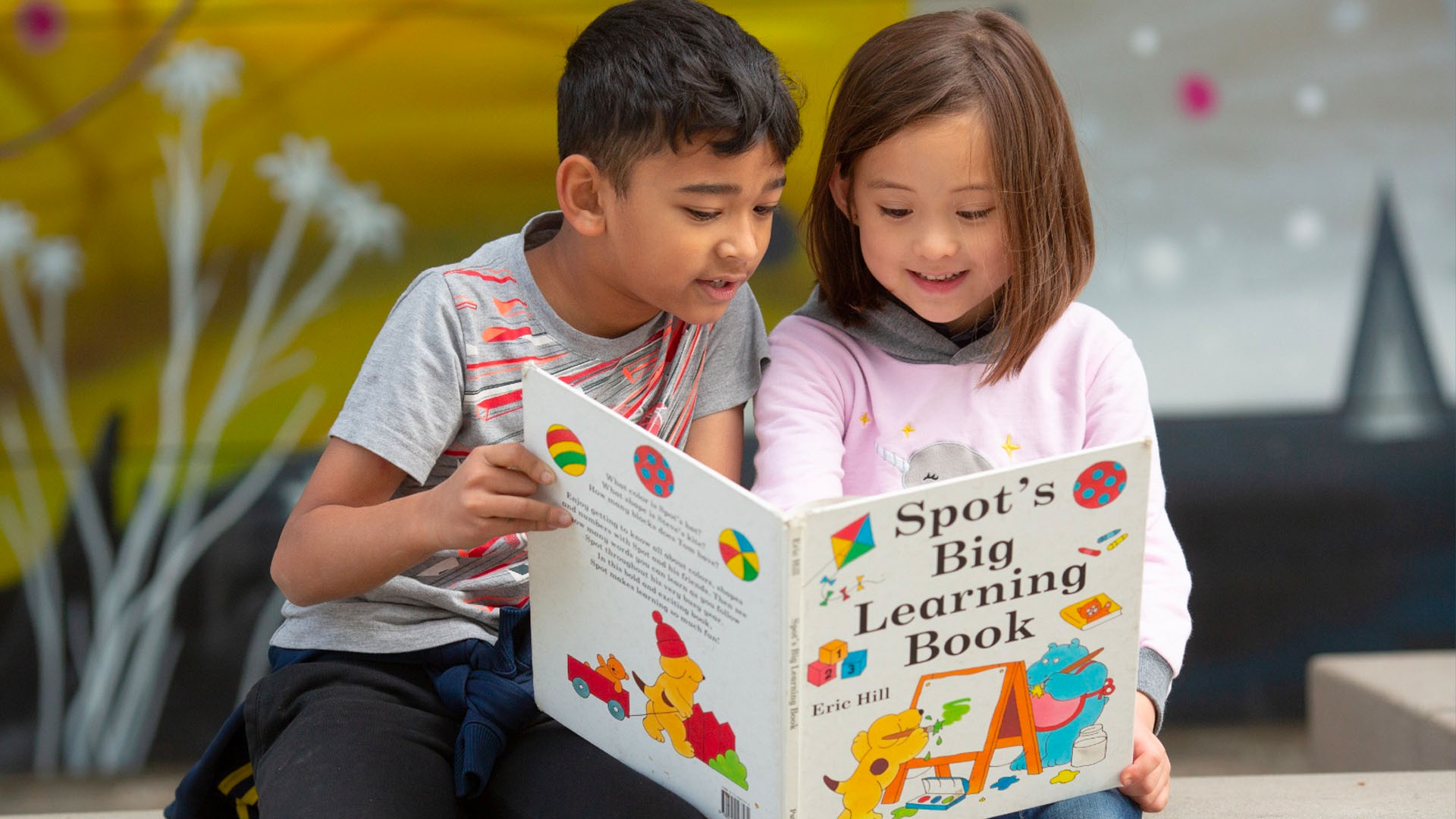
In PART 1 of this blog post we started to unpack how we can shift the balance in literacy instruction. If you missed it, we started to unpack how reading comprehension begins, recommitting to phonemic awareness, and reimagining the way we teach phonics. We educators do not like conflict. All day long we work to resolve conflicts with people of all ages. It’s our job to keep the peace, find the middle ground, and keep everything running just as it should be. One of my go-to mantras is, ‘It’s fine. Everything is fine. I’m fine. I’m fine.’ But, we can only carry around so much of that pressure before we need to pause, regroup, and carry onward to stay well. There is a lot of tension out there in the world of literacy instruction. You may be deep in it, or you may be hiding waiting for things to blow over. The importance of making sure that we are providing our earliest readers with the best tools to be successful helped me to decide that I had a few options:
- Listen but keep on as is.
- Get involved in the debate in some way.
- Listen to the research and data and get involved with shifting any areas that are in need of shifting.
Bukins and Yates urge us as educators to tap into our growth mindset dispositions and move from walls to bridges. These questions got me engaged and eager to learn more:
- Is it possible that the balanced literacy classrooms are sometimes out of balance?
- Are we missing (or misunderstanding) ways to bridge the most current research into our classroom?
- Do we have seemingly logical practices that are driven more by our intuition than driven by how science has taught us about how reading actually works in the brain?
- Could a few simple, but powerful, shifts help us unlock literacy for more children than in the past?
While we may still be at the top most portion of an iceberg, the approach Burkins and Yates have taken to the tension is respectable and admirable. I hope you find this overview of some important considerations in our work as educators. Let’s start having more conversations about this topic so we can move forward. In this post we will unpack three of the six shifts.” — Introduction of Bravely Embracing Science and Balance part 1 The purpose of these 2 blog posts is to highlight the information presented by Burkins and Yates in a brief over format to help guide conversations in classrooms, schools, and districts.
Shift 4 – Revisint High-Frequency Word Instruction
Common Practice to REconsider |
Scientifically Sound Shift |
|---|---|
| Taking a “just-have-to-memorize-them” approach to teaching high frequency words. | Create opportunities for children to “pull apart” the phonemes in high-priority words and match each one to the grapheme(s) that represent them. |

Sight words and high-frequency words are not the same. This chapter reminds us that 109 of the high frequency words (see list in resources) make up 50% of words in children’s texts. High frequency words described as irregular (or un-decodable) have patterns that are more decodable than we realize. Sound spelling work (orthographic mapping) is essential for readers to decode and encode. Science Snapshot:
- A sight word is any word that the brain recognizes automatically.
- High-frequency words are especially high leverage because of how often they are found in written texts.
- Knowing as few as 13 of the 109 most frequently occurring words unlocks 25-50 percent of all texts written for children.
- Proficient readers don’t memorize whole words, even though they look as though they do. They rapidly process every letter in a word.
- To establish any word as a sight word, anchoring it in the visual word form area requires orthographic mapping.
- Lexical quality depends on how much phonological, orthographic, meaning, and context knowledge a reader/writer has accumulated about a word (engaging all four processing systems).
- Reading and writing fluency varies based on the lexical quality of the words we know, because higher lexical quality makes retrieval of information automatic.
Resources That May Interest You
Shift 5 – Reinventing the Ways We Use MSV (3 Cueing Systems)
Common Practice to REconsider |
Scientifically Sound Shift |
|---|---|
| Treating decoding as a strategy of last resort. | Prioritize print as a strategy of first resort for word solving, using meaning and structure to cross-check. |
In the MSV model:
- M = meaning (contextual supports) = Did that make sense?
- S = structure (syntactical information) = What would sound right?
- V = visual (letters and letter patterns) = Get your mouth ready. Does that look right?
Should we tell students to “sound it out?” Yes and no. Coaching students to “sound it out” can be reclaimed to visual information. Children need explicit instruction, modeling, and practice to learn what “sound it out” actually means. Science Snapshot:
- MSV is a common reading model used in many balanced literacy classrooms.
- In aligning the MSV model with the Four-Part Processing Model:
- V = orthographic processing system
- M and S = represent both meaning and context processing systems
- Phonological processing is not explicitly represented in MSV as implied by the three cueing systems.
- Meaning and language structure are important sources of information for supporting an approximation and cross checking.
- Building automaticity with word recognition is essential for fluency and comprehension because it frees up attention for sense-making.
- Proficient readers attend to every bit of visual information, looking sequentially from left to right.
- Relying on context as a first resort can keep readers locked in earlier phases of development.
- As texts get more difficult, context becomes less and less helpful for figuring out individual words.
- The beginning readers’ slow decoding work leads to the long-term benefits of orthographic mapping, fluency and comprehension.
Resources That May Interest You
Shift 6 – Reconsidering Texts for Beginning Readers
Common Practice to REconsider |
Scientifically Sound Shift |
|---|---|
| Over relying on predictable texts to get kids quickly up and reading. | Thoughtfully select or create texts with the decoding opportunities students need to practice. |
Decodable texts for emergent readers and patterned texts both have their pros and cons. When providing practice to crack the phonetic code the following tensions arise:
- Decodability vs predictability
- Novelty vs repetition
- Orthographic value vs sense making value
We must ensure that beginning readers spend more time in “read all the words” texts to “shore up” the early phonics principles they are working to internalize. Science Snapshot:
- Both decodable and predictable texts have limitations.
- Selecting text for beginning readers requires special attention to the text’s decoding demands.
- All texts are decodable and predictable, to varying degrees
- Although predictable texts seem to make learning to read easier, they create problems in the long run.
- Orthographic learning comes from effort spent decoding a mix of sound-spelling patterns aligned with what is being taught.
- Orthographic frustration comes from expending effort decoding sound-spellings children have not mastered yet.
- Oral language experiences supplement beginning readers.
Resources That May Interest You
I hope you have enjoyed reading a bit more about how we can shift the balance to maximize our literacy instruction. If you have additional questions, thoughts, resources, or want to continue the dialogue feel free to email me!
Resources
Please login or register to claim PGPs.
Alternatively, you may use the PGP Request Form if you prefer to not register an account.



